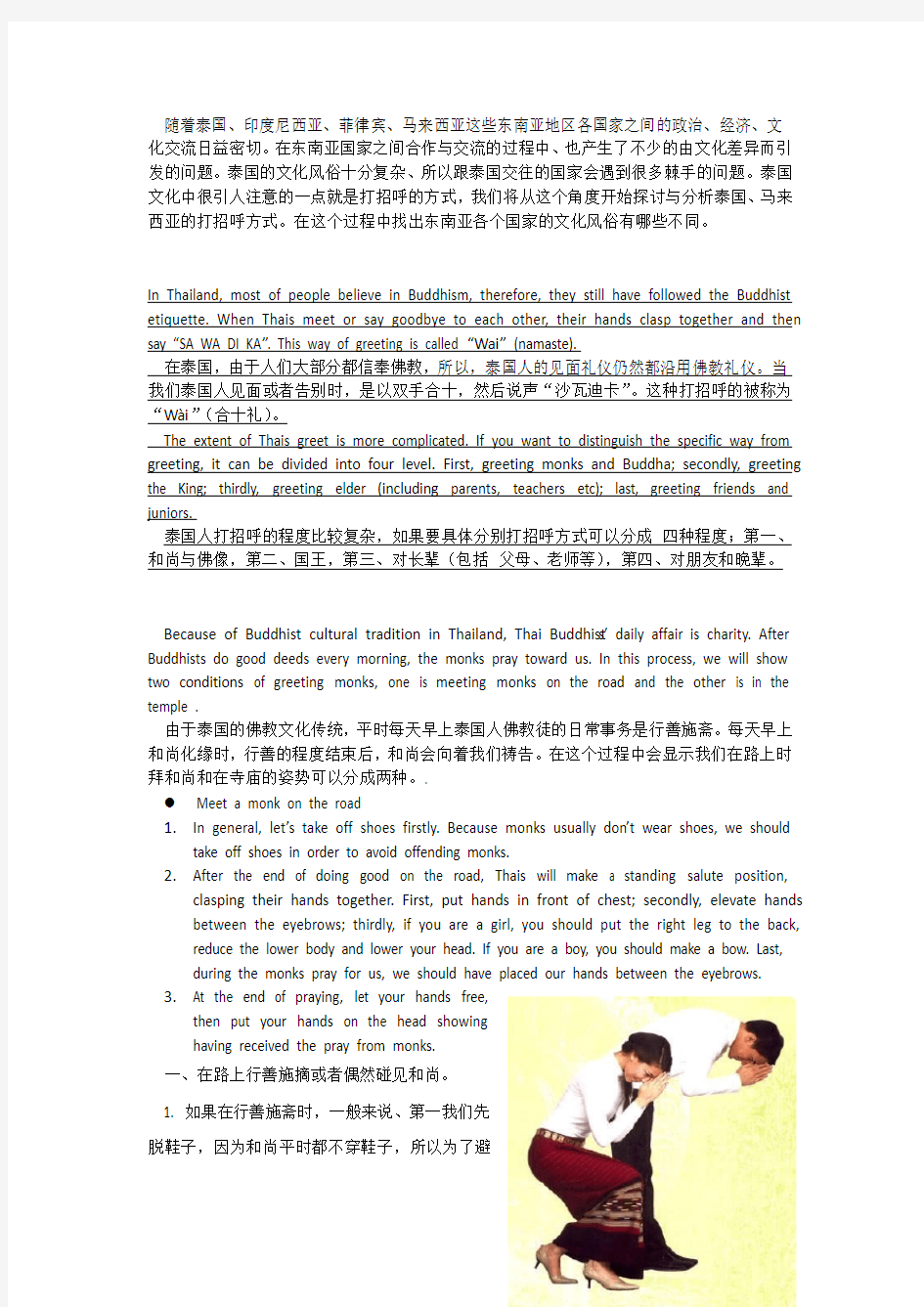东南亚打招呼的方式

- 1、下载文档前请自行甄别文档内容的完整性,平台不提供额外的编辑、内容补充、找答案等附加服务。
- 2、"仅部分预览"的文档,不可在线预览部分如存在完整性等问题,可反馈申请退款(可完整预览的文档不适用该条件!)。
- 3、如文档侵犯您的权益,请联系客服反馈,我们会尽快为您处理(人工客服工作时间:9:00-18:30)。
随着泰国、印度尼西亚、菲律宾、马来西亚这些东南亚地区各国家之间的政治、经济、文化交流日益密切。在东南亚国家之间合作与交流的过程中、也产生了不少的由文化差异而引发的问题。泰国的文化风俗十分复杂、所以跟泰国交往的国家会遇到很多棘手的问题。泰国文化中很引人注意的一点就是打招呼的方式,我们将从这个角度开始探讨与分析泰国、马来西亚的打招呼方式。在这个过程中找出东南亚各个国家的文化风俗有哪些不同。
In Thailand, most of people believe in Buddhism, therefore, they still have followed the Buddhist etiquette. When Thais meet or say goodbye to each other, their hands clasp together and then say “SA WA DI KA”. This way of greeting is called “Wai” (namaste).
在泰国,由于人们大部分都信奉佛教,所以,泰国人的见面礼仪仍然都沿用佛教礼仪。当我们泰国人见面或者告别时,是以双手合十,然后说声“沙瓦迪卡”。这种打招呼的被称为“Wài”(合十礼)。
The extent of Thais greet is more complicated. If you want to distinguish the specific way from greeting, it can be divided into four level. First, greeting monks and Buddha; secondly, greeting the King; thirdly, greeting elder (including parents, teachers etc); last, greeting friends and juniors.
泰国人打招呼的程度比较复杂,如果要具体分别打招呼方式可以分成四种程度;第一、和尚与佛像,第二、国王,第三、对长辈(包括父母、老师等),第四、对朋友和晚辈。
Because of Buddhist cultural tradition in Thailand, Thai Buddhist s’ daily affair is charity. After Buddhists do good deeds every morning, the monks pray toward us. In this process, we will show two conditions of greeting monks, one is meeting monks on the road and the other is in the temple .
由于泰国的佛教文化传统,平时每天早上泰国人佛教徒的日常事务是行善施斋。每天早上和尚化缘时,行善的程度结束后,和尚会向着我们祷告。在这个过程中会显示我们在路上时拜和尚和在寺庙的姿势可以分成两种。.
Meet a monk on the road
1.In general, let’s take off shoes firstly. Because monks usually don’t wear shoes, we should
take off shoes in order to avoid offending monks.
2.After the end of doing good on the road, Thais will make a standing salute position,
clasping their hands together. First, put hands in front of chest; secondly, elevate hands between the eyebrows; thirdly, if you are a girl, you should put the right leg to the back, reduce the lower body and lower your head. If you are a boy, you should make a bow. Last, during the monks pray for us, we should have placed our hands between the eyebrows. 3.At the end of praying, let your hands free,
then put your hands on the head showing
having received the pray from monks.
一、在路上行善施摘或者偶然碰见和尚。
1. 如果在行善施斋时,一般来说、第一我们先
脱鞋子,因为和尚平时都不穿鞋子,所以为了避
免不敬和尚的行为,我们应该脱鞋子。
2. 在路上行善结束后,我们会做出站着行礼姿势,然后双手合十,第一、放在胸之间,第二、把手抬高到眉毛之间、第三,女生:把右腿退到后面、降低下身、低下头,男生:往前面弯下身、低下头,第四、在和尚对我们祷告的过程中,我们的手还是一直放在眉毛之间。
3. 和尚祷告结束时,从双手合十放在眉毛中就放开然后用两双手来摸自己的头表示已经接接受到和尚的祷告。
●Meet monk in the temple
Thai Buddhists usually make a “Krabe”(跪拜礼), when they meet monks and Buddha in the temple. ”Krabe” contains three steps.
1.We drop to our knees first, girls should make feet on the floor and body upright, and boys
should make feet toes against the ground and feet upright.
2.First, make our hands clasped together in front of chest, then carry clasped hands between
the eyebrows and bow head. Next, stoop the body to the floor with clasped hands and bow head between the outstretched hands.
3.Redo the above action three times.
●在寺庙行善施斋见面和尚与佛像。
我们泰国佛教徒,一般在寺庙见面和尚与佛像会做出
“Krabe”(跪拜礼)俯伏的姿势。“Krabe” 姿势的过
程中主要有;
1. 我们是先跪下,女生:两脚贴在地板上、身体竖直,
男生:两脚脚趾抵在地上,竖起脚掌。
2. 双手合十放在胸之间,把双手合十抬上直到眉毛之
间、低下头,然后身体俯伏而要弯身直到地板上,双手
合十伸开放在地板上,头也低下直到地板上也是贴在双
手伸开之间
3. 上面的动作重新做三遍,就是完成向和尚与佛像行礼的姿势。
The Thai king are very respected and beloved by Thai people, so the posture of saluting to the king would be more special. If there is a precious opportunity to face the king, whatever girls and
